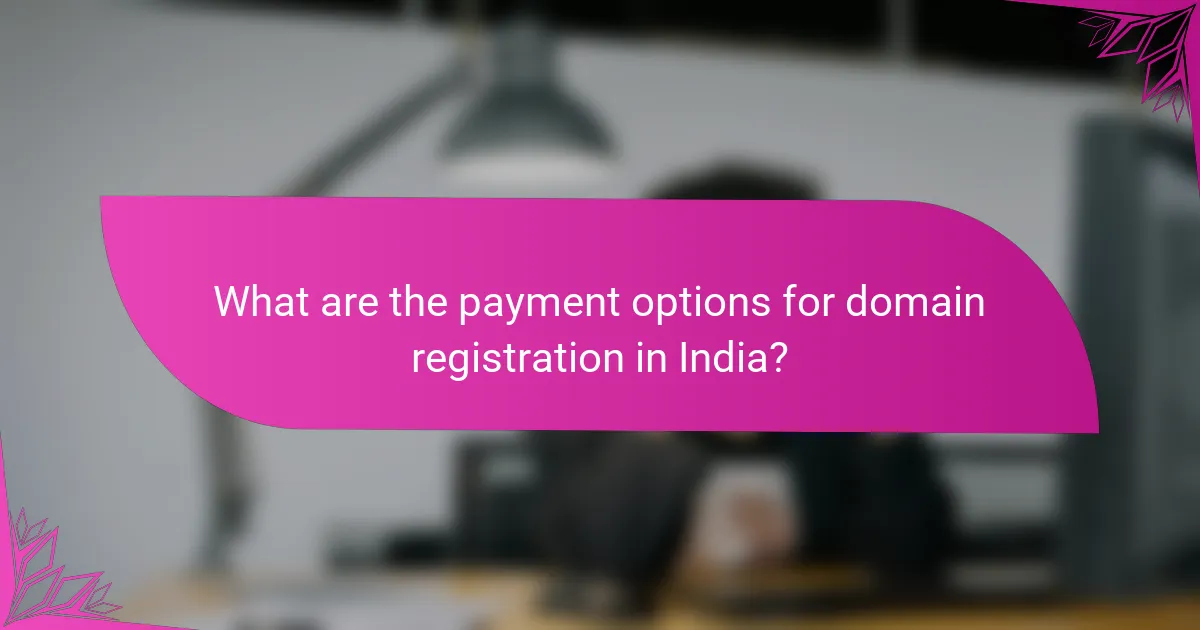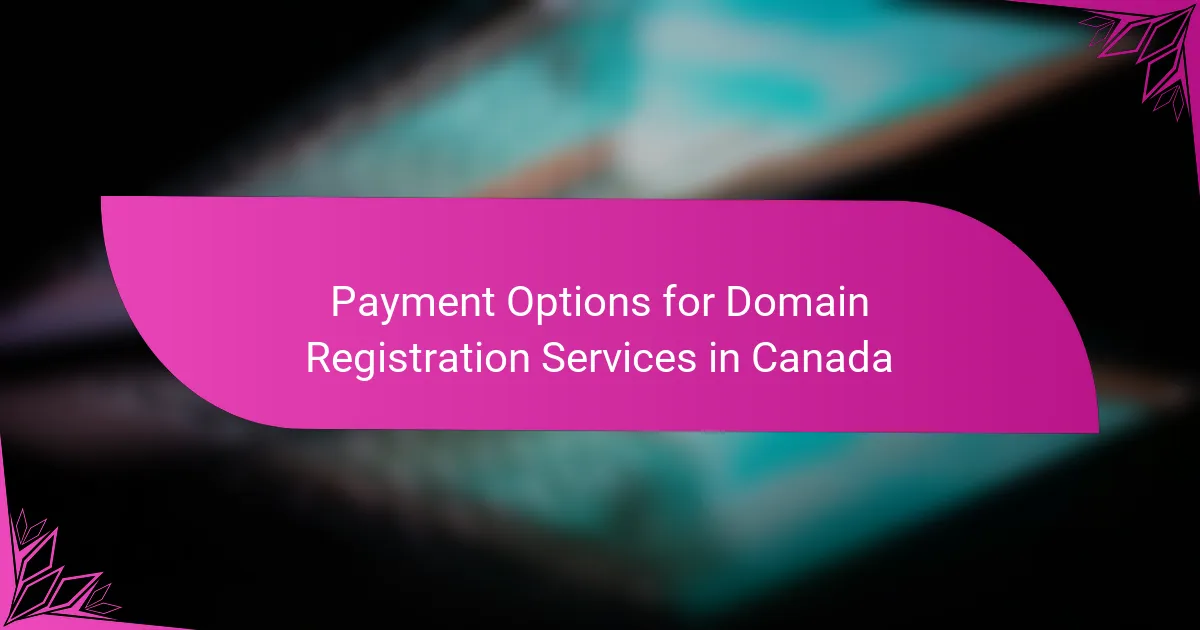In India, domain registration services provide a variety of payment options to suit different user needs, including credit and debit cards, net banking, UPI payments, digital wallets, and even cryptocurrency. Selecting the right payment method involves evaluating factors such as transaction fees, security, and user convenience, as each option presents its own benefits and challenges. Utilizing local payment methods can enhance the transaction experience by reducing costs and streamlining the process through better alignment with local banking systems.

What are the payment options for domain registration in India?
In India, domain registration services offer several payment options to accommodate various user preferences. The most common methods include credit and debit cards, net banking, UPI payments, digital wallets, and cryptocurrency.
Credit and debit cards
Credit and debit cards are widely accepted for domain registration in India, making them a convenient option for many users. Most registrars support major card networks like Visa, MasterCard, and American Express.
When using cards, ensure that your card is enabled for international transactions if you’re registering with a foreign registrar. Be aware of any additional processing fees that may apply, typically ranging from 1% to 3% of the transaction amount.
Net banking
Net banking allows users to make direct payments from their bank accounts, providing a secure and straightforward method for domain registration. Most Indian banks support this option, and it is often preferred for its ease of use.
To use net banking, select your bank during the payment process and follow the prompts to complete the transaction. Keep in mind that processing times can vary, with some payments being instant while others may take a few hours to reflect.
UPI payments
Unified Payments Interface (UPI) has gained popularity in India for its quick and seamless transactions. Many domain registrars now accept UPI payments, allowing users to pay directly from their mobile wallets or bank accounts.
To use UPI, simply select it as your payment option, enter your UPI ID, and authorize the payment through your UPI app. This method is typically instant, making it a favored choice for many users.
Digital wallets
Digital wallets like Paytm, PhonePe, and Google Pay are increasingly being accepted for domain registration payments in India. These wallets offer a quick way to pay without needing to enter bank details each time.
When using a digital wallet, ensure you have sufficient balance or a linked bank account for seamless transactions. Some registrars may offer discounts or cashback for payments made through specific wallets, so check for any promotional offers.
Cryptocurrency
While still not mainstream, some domain registrars in India are beginning to accept cryptocurrency as a payment method. This option can be appealing for tech-savvy users looking for anonymity and security.
When paying with cryptocurrency, be aware of the volatility in prices and potential transaction fees. Ensure that the registrar you choose clearly outlines their cryptocurrency policies and accepted coins, as this can vary widely.

How to choose the best payment method for domain registration?
Choosing the best payment method for domain registration in India involves considering transaction fees, security, and ease of use. Each payment option has its own advantages and potential drawbacks that can affect your overall experience.
Consider transaction fees
Transaction fees can significantly impact the total cost of domain registration. Different payment methods, such as credit cards, debit cards, and digital wallets, may have varying fees associated with them. For example, while credit card payments might incur a small percentage fee, bank transfers could be fee-free but may take longer to process.
To minimize costs, compare the transaction fees of each payment method before making a decision. Look for services that offer promotions or discounts for specific payment types, as this can lead to savings on your domain registration.
Evaluate payment security
Payment security is crucial when registering a domain, as sensitive information is often exchanged. Ensure that the payment method you choose is secure and offers protection against fraud. Credit cards typically provide robust fraud protection, while digital wallets often use encryption to safeguard your data.
Check if the domain registration service complies with local regulations and standards for online transactions, such as PCI DSS. This compliance can give you added confidence in the security of your payment method.
Assess ease of use
The ease of use of a payment method can greatly affect your domain registration experience. Some methods, like credit cards and digital wallets, allow for quick and seamless transactions, while others, such as bank transfers, may require additional steps and time for processing.
Consider your own preferences and familiarity with each payment option. If you prioritize speed and convenience, opt for methods that offer instant confirmation and minimal hassle. Always ensure that the payment interface is user-friendly to avoid complications during the registration process.

What are the benefits of using local payment options?
Using local payment options for domain registration services in India offers several advantages, including reduced costs and enhanced convenience. These methods often align better with local banking systems, leading to a smoother transaction experience.
Lower transaction costs
Local payment options typically incur lower transaction fees compared to international methods. For instance, using UPI or net banking can save users from foreign transaction fees that credit cards might impose, which can range from 2-5% of the total amount.
Additionally, many local providers offer promotions or discounts for using specific payment methods, further reducing overall costs. This can be particularly beneficial for small businesses or individuals registering multiple domains.
Faster processing times
Transactions made through local payment options are generally processed much quicker than international payments. For example, payments via UPI often reflect in real-time, allowing users to complete their domain registration almost instantly.
In contrast, international credit card transactions can take several hours or even days to clear, which can delay the registration process. Choosing local options ensures that your domain is secured without unnecessary waiting periods.
Better customer support
Using local payment options often leads to improved customer support, as providers are more familiar with local banking practices and regulations. This can result in quicker resolutions for any issues that may arise during the payment process.
Moreover, local payment services typically offer support in regional languages, making it easier for users to communicate their concerns. This accessibility can enhance the overall user experience when registering domains.

Are there subscription models for domain registration in India?
Yes, there are subscription models for domain registration in India, primarily through annual and multi-year plans. These models allow users to secure their domain names for specified periods, with varying pricing and renewal options.
Annual subscription plans
Annual subscription plans are the most common option for domain registration in India. Users pay a fee to register their domain for one year, with the option to renew before the expiration date. Prices typically range from a few hundred to several thousand Indian Rupees, depending on the domain extension and registrar.
When choosing an annual plan, consider the renewal rates, as they can differ significantly from the initial registration cost. Some registrars offer discounts for the first year, which may lead to higher renewal fees later on.
Multi-year registration options
Multi-year registration options allow users to register their domain for multiple years, often at a reduced rate compared to renewing annually. This can be a cost-effective choice for businesses or individuals planning to maintain their online presence long-term.
Multi-year plans typically range from two to ten years. It’s essential to check if the registrar provides a discount for longer commitments and to understand the terms regarding renewal and transferability during the registration period.

What are the risks associated with online payment for domains?
Online payment for domain registration carries several risks, primarily related to security and fraud. Users must be vigilant about the payment methods they choose and the platforms they use to avoid potential financial loss.
Fraudulent transactions
Fraudulent transactions occur when unauthorized individuals use stolen payment information to purchase domains. This can lead to significant financial losses for the victim, who may not realize the fraud until after the transaction is completed.
To mitigate the risk of fraudulent transactions, use reputable domain registrars that offer secure payment gateways. Look for platforms that provide two-factor authentication and encryption to protect your payment details.
Additionally, monitor your bank statements regularly for any unauthorized charges. If you notice anything suspicious, report it to your bank immediately to prevent further losses.
